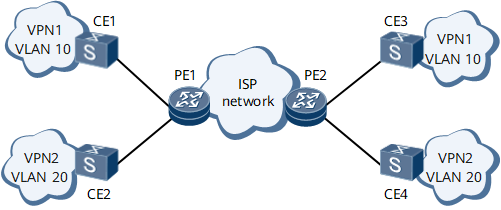Application of EVC VPWS Services
Service Description
As globalization gains momentum, more and more enterprises set up branches in foreign countries and requirements for office flexibility are increasing. An urgent demand for carriers is to provide Layer 2 links for enterprises to set up their own enterprise networks, so that enterprise employees can conveniently visit enterprise intranets outside their offices.
By combining previous access modes with the current IP backbone network, VPWS prevents duplicate network construction and saves operation costs.
Networking Description
In the traditional service model supported by the NetEngine 8000 F, common sub-interfaces (VLAN type), Dot1q VLAN tag termination sub-interfaces, or QinQ VLAN tag termination sub-interfaces are created on the user-side interfaces of PEs. These sub-interfaces are bound to different VSIs on the carrier network. If Layer 2 devices use different access modes on a network, service management and configuration are complicated and difficult. To resolve this issue, configure an EVC to carry Layer 2 services. This implementation facilitates network planning and management, driving down enterprise costs.
On the VPWS network shown in Figure 1, VPN1 services use the EVC VPWS model. The traffic encapsulation type and behavior are configured on the PE to ensure service connectivity within the same VPN instance.
Feature Deployment
- Create a Layer 2 EVC sub-interface on the PE and specify the traffic encapsulation type and behavior on the Layer 2 sub-interface.
- Configure VPWS on the EVC Layer 2 sub-interface.
